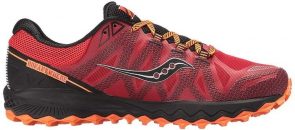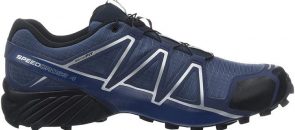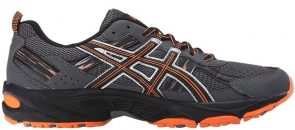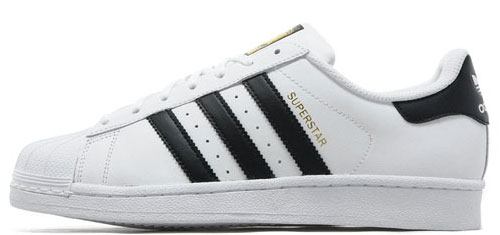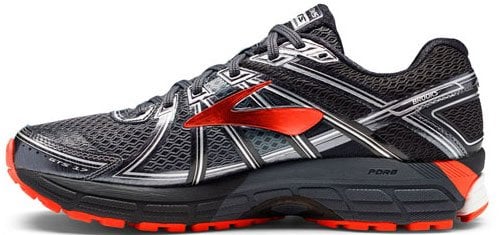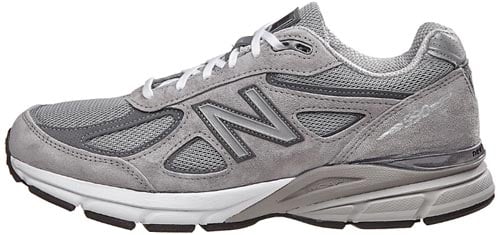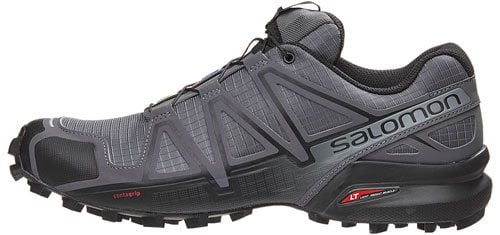- By Mark
- Expert
Why choose to buy specialized trail running shoes at all? We pick 15 best trail running shoes for stability, traction, trail feel, comfort, and underfoot protection.
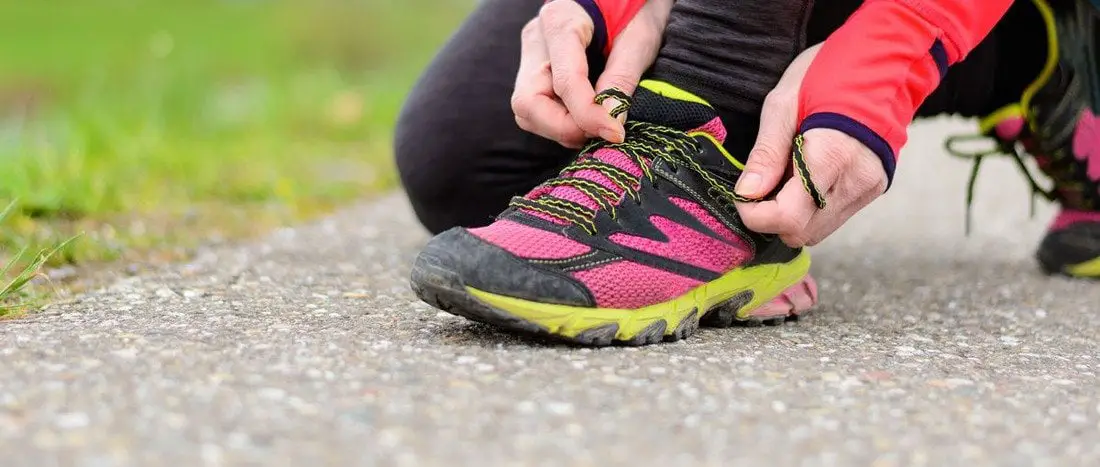
What's the best trail running shoes you can buy?
15 Best Trail Running Shoes

#1 Saucony Peregrine 7
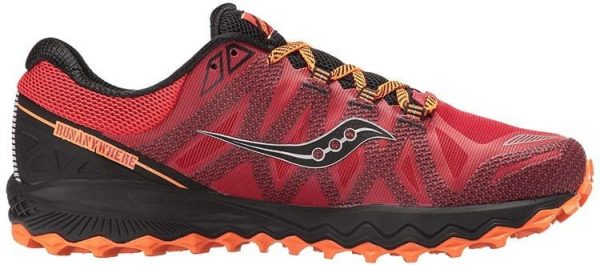
Specification
- Brand: Saucony
- Arc Support: Neutral
- Heel to Toe Drop: 4mm
- Weight: M 266g | W 238g
- Release Date: Jan 2017
This is a perfect trail shoe that will allow you to tackle any type of terrain, regardless of how fast you are running. They are excellent on hard surfaces, making them the perfect shoe if you are looking for a shoe that you can wear from your door to the trail.
Size and Fit
The Peregrine 7 provides you with a surprisingly good fit. The forefoot is quite roomy, and the exoskeleton of the shoe secures your midfoot very well. This gives those with small feet the confidence to attack even the most technical terrain.
Pros
- The upper is very breathable, giving you the confidence to run for longer.
- The heel padding is thicker in the new Peregrine 7, which helps to hold your feet better.
- Despite the thick rubber outsole, the shoe provides you with excellent ground-feel.
Cons
- The heel counter is slightly more rigid than before, which can be uncomfortable for your feet, especially on long runs.
- The toe bumper does not do an excellent job at protecting your forefoot as it is quite soft.

#2 Salomon Speedcross 4
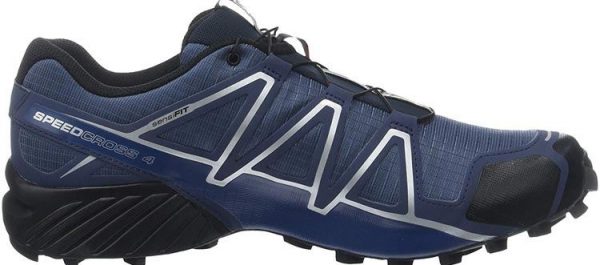
Specification
- Brand: Salomon
- Arc Support: Neutral
- Heel to Toe Drop: 10mm
- Weight: M 310g | W 260g
- Release Date: Aug 2016
This shoe’s insane traction is something that will please any runner who buys it. However, it is a very unstable shoe, meaning much more care is needed when you are on the trail.
Size and Fit
This is a very comfortable shoe, especially for hikers and trail runners. The shoe is very well padded, and while the sure lace system helps to secure your foot to the shoe. The heel feels great, and the size of the shoe is just perfect.
Pros
- Traction is excellent on every surface, especially mud and snow.
- The shoe provides you with excellent ground feedback.
- Much lighter than previous models.
Cons
- The stack is very high, which may be an issue on rugged terrain.
- It does not dry very quickly when it does absorb water.

#3 ASICS Gel Venture 5
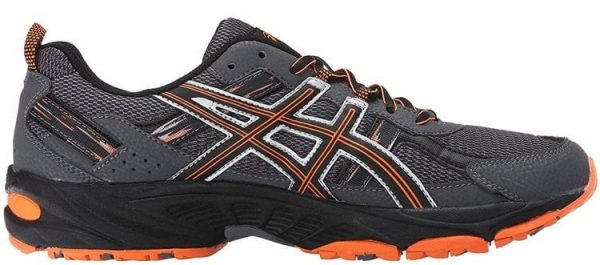
Specification
- Brand: ASICS
- Arc Support: Neutral
- Heel to Toe Drop: 10mm
- Weight: M 303g | W 247g
- Release Date: -
This shoe is a best selling shoe for a reason. Not only is it good for trail running and hiking, but it can be used for road running as well. This versatility makes it ideal, especially if you are looking for a shoe that you can use from the door to the trail.
Size and Fit
These are some well-fitting shoes. They offer you a snug fit, while still providing you with a toe box that is roomy enough to accommodate even the widest feet. They also provide you with excellent arch support.
Pros
- Wide toe box that allows natural toe splaying.
- The outsole is designed to provide you with traction almost anywhere.
- Comes with a removable sock liner to help those with foot issues.
Cons
- The shoes tend to struggle when used on wet rocks.
- The excellent foot protection compromises the flexibility of the shoe.

#4 Pearl iZumi Trail EM N2 V3
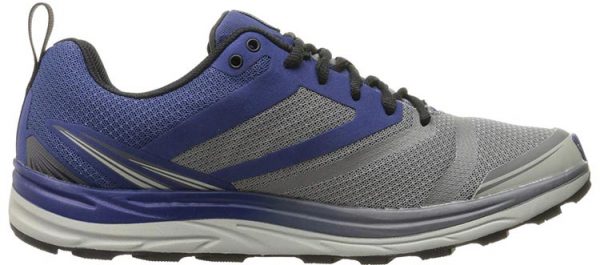
Specification
- Brand: Pearl iZumi
- Arc Support: Neutral
- Heel to Toe Drop: 4mm
- Weight: M 312g | W 283g
- Release Date: -
This is perhaps the best all-around shoe you can buy right now. It is perfect for everyone, regardless of whether you are an experienced trail runner or an amateur.
Size and Fit
This seamless shoes 3D printed upper gives the shoe an excellent, comfortable feel. The sure-lace system helps to keep the shoes secured to your feet all day. However, the shoes do feel a little longer and a perfect than usual, so it is recommended that you try them on first before committing to a size.
Pros
- Reflective tongue mesh allows you to be seen from up to 800 feet away.
- Surprisingly lightweight thanks to the center mesh.
- The shoes do not absorb water quickly and dry very fast when they become wet.
Cons
- The shoes feel large, which means you may have to try them out before you pick a shoe size.
- They do not provide you with the same level of sensitivity than many other trail shoes on the market today.

#5 New Balance Leadville V3
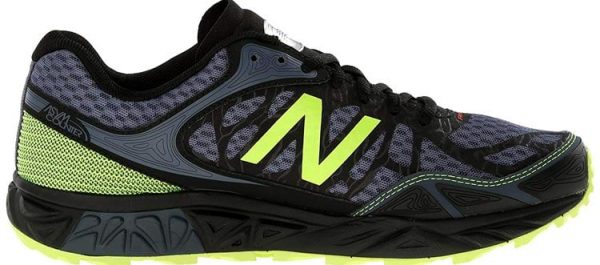
Specification
- Brand: New Balance
- Arc Support: Stability
- Heel to Toe Drop: 8mm
- Weight: M 293g | W 248g
- Release Date: -
For a shoe that was designed to tackle the 100 mile Leadville Trail 100, this shoe will definitely go the distance. However, the lackluster sensitivity and the wide heel mean that you should approach them with caution.
Size and Fit
These shoes feel great from the moment you take them out of the box. They are cushioned in all the right places, while the sure-lace system guarantees that the shoes are secured to your feet at all times. However, the heel is a little wide, meaning that those with narrow heels may have issues.
Pros
- The upper does an excellent job of repelling debris.
- The shoe is brilliant at protecting your feet thanks to a toe guard and Gusseted tongue.
- The shoe is well cushioned and even helps to add a little springiness in the forefoot.
Cons
- The sole is not as durable as other trail shoes.
- It is not as sensitive as previous versions.
- It is too wide in the heel area.

#6 Brooks Cascadia 12
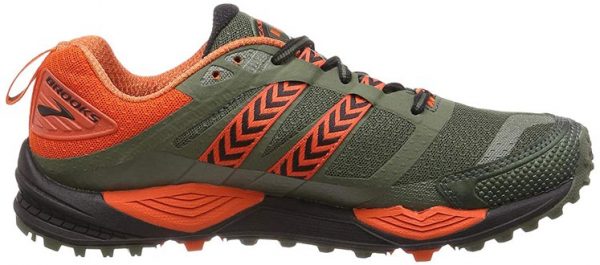
Specification
- Brand: Brooks
- Arc Support: Neutral
- Heel to Toe Drop: 10mm
- Weight: M 343g | W 298g
- Release Date: Jan 2017
These are excellent shoes for those transitioning from road to trail running. They are also very good for long runs and hikes. However, they are not the best shoe for those that have fat or wide feet.
Size and Fit
These shoes are so comfortable you can run for miles in them straight out of the box. They are quite snug around the midfoot which means better grip when cornering. The lacing system may be a little strange, but it does provide you with above average security and stability.
Pros
- The 10mm heel drop makes this the perfect trail shoe for those that would like to transition from road to trail running.
- Superior comfort allows you to go for longer runs.
- They offer perfect grip on all surfaces.
Cons
- The snug fit means that they may not be ideal for those with fat feet.
- They are not as sensitive as other trail shoes.
- They feel heavy on your feet.

#7 Merrell Trail Glove 3
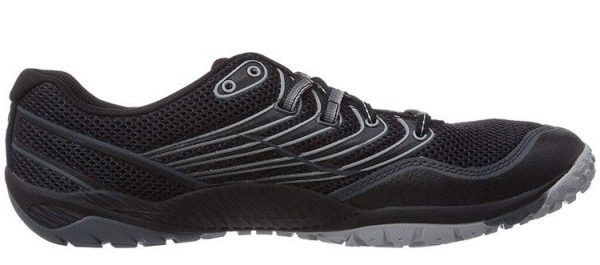
Specification
- Brand: Merrell
- Arc Support: Neutral
- Heel to Toe Drop: 0mm
- Weight: M 198g | W 167g
- Release Date: Jul 2014
This is the perfect shoe if you are into minimalist or barefoot running. However, if you are looking to transition to minimalist running, these shoes may be a little harsh on the feet.
Size and Fit
Merrell designed these shoes to be as minimalist as possible. This means that there is not much cushioning compared to other trail shoes. However, they are still a comfortable shoe and may make you believe you are not wearing anything at all on your feet.
Pros
- Very lightweight and durable.
- Fit your foot like a glove.
- You can use them on virtually any terrain.
- They are very breathable and keep your foot cool and dry.
Cons
- They are not suitable for those who are not used to minimalist shoes.

#8 ASICS Gel Fujitrabuco 4
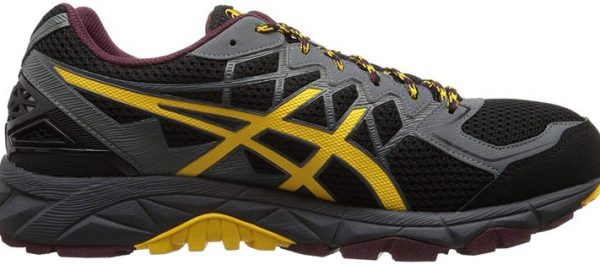
Specification
- Brand: ASICS
- Arc Support: Neutral
- Heel to Toe Drop: 10mm
- Weight: M 332g | W 275g
- Release Date: -
Despite the weight of the shoe, this is a brilliant all-around trail running shoe. It offers runners with excellent support while guaranteeing that they will be able to explore any terrain that they please.
Size and Fit
As usual Asics running shoes, this shoe fits way better than its predecessor. The wide forefoot provides you with better stability. Also, the wider laces help to lock your foot into the shoe much better. The cushioning is better than most other shoes, and the MONO-SOCK liner means that there are no rub points in the shoe.
Pros
- MONO-SOCK fit system provides you with a better, personalized fit.
- The outsole provides you with excellent traction.
- It comes with a host of trail protection features, including a midsole rock plate.
Cons
- It is quite a heavy shoe.
- It is not as sensitive as many other trail shoes.

#9 Nike Air Zoom Terra Kiger 3
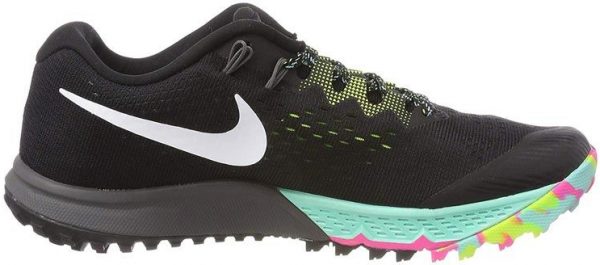
Specification
- Brand: Nike
- Arc Support: Neutral
- Heel to Toe Drop: 4mm
- Weight: M 255g | W 204g
- Release Date: Jul 2015
Even though it may not be the most sensitive shoe, this is one of the best purchases you will make this year. If you are looking for a trail shoe that is light, fashionable and able to take you through a full race day, this is the shoe for you.
Size and Fit
Nike has maintained their dominance of the shoe industry with this trail shoe. It is by far one of the most comfortable shoes on this list. The upper is snug and holds your foot securely in place even over the toughest terrain.
Pros
- Dynamic Fit system helps to ensure that you get the best fit possible.
- Foot protection is amongst the best of all the trail shoes you can buy right now.
- The wider forefoot means that you get superior stability.
Cons
- The upper does not do a very good job of protecting your feet.
- The hard rock plate and cushioning help to reduce the sensitivity of the shoe.
- It absorbs water faster than most other trail shoes.

#10 The North Face Ultra Endurance
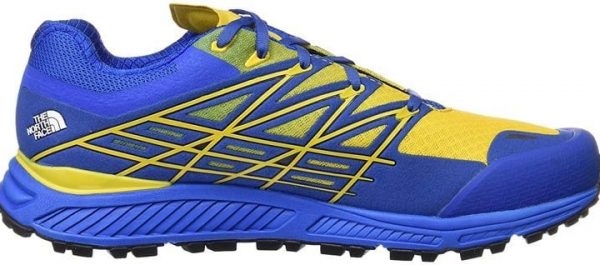
Specification
- Brand: The North Face
- Arc Support: Neutral
- Heel to Toe Drop: 8mm
- Weight: M 313g | W 255g
- Release Date: -
If you are looking for a durable trail running shoe, then you should look no further. Not only are these excellent shoe value for money, but they are also ideal for almost any application you can imagine.
Size and Fit
This shoe has one of the best uppers of any shoe on the market today. In fact, it feels so good you may think you are wearing slippers. The 17 mm cushioning in the heel also helps to make the shoe more comfortable.
Pros
- Wide forefoot, combined with 9mm of cushioning, makes this a very stable shoe.
- The arrow-shaped lugs provide you with superior traction, especially when going up or down hills.
- The "snake plate" provides your feet with excellent protection.
Cons
- The protection means that they are not very sensitive.
- They absorb water very quickly.
- These are some of the heaviest shoes in this review.

#11 La Sportiva Bushido
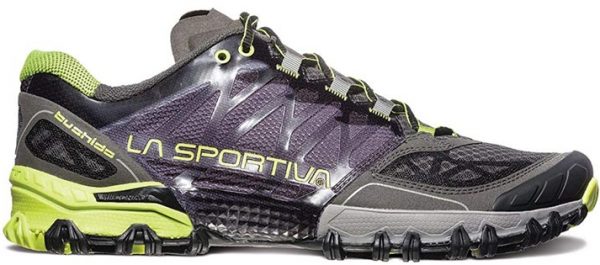
Specification
- Brand: La Sportiva
- Arc Support: Stability
- Heel to Toe Drop: 6mm
- Weight: M 298g | W 257g
- Release Date: -
The Bushido is one of the highest rated shoes you will find, for a good reason. The exceptional protection, coupled with the superior stability, make this one of the best shoes you will see for trail running.
Size and Fit
The Bushido is a rather rigid shoe, making it a little uncomfortable. However, the shoe provides you with a very good fit. This is especially true if you have narrow feet. The best part about them is that the wide toe box allows your foot to swell when you are running long distances.
Pros
- Wide toe box allows for your foot to swell naturally.
- The shoe dries very quickly when wet.
- Has exceptional foot protection, including a hard toe cap and rigid outsole and midsole rock plate.
Cons
- Rigidity of the shoe means that it is not as comfortable as other trail shoes.
- It is quite a heavy shoe.
- Heel cup does not stop slipping very well.
#12 Hoka One One Challenger ATR 3
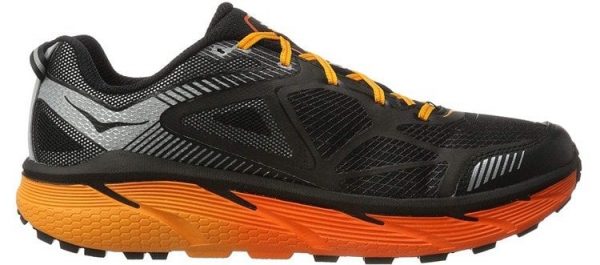
Specification
- Brand: Hoka One One
- Arc Support: Neutral
- Heel to Toe Drop: 5mm
- Weight: M 269g | W 224g
- Release Date: Feb 2017
This is a shoe you should consider if you are looking for a door to trail shoe. Its lightweight nature and excellent traction mean that you will be able to go just about anywhere. However, if you are planning on running over rocky trails regularly, the durability of the shoe will be an issue.
Size and Fit
This shoe has a wide toe box to help give you better comfort. It also has some of the best cushioning on the market, and the new improved upper helps to provide your feet with more support.
Pros
- Breathable upper offers excellent ventilation.
- Outsole promises to continue providing you with traction even after 500 miles.
- Wider forefoot guarantees better stability.
Cons
- Slightly more expensive than the other shoes on this list.
- Not suitable for those people who run on rougher trails, as outsole durability in such conditions is questionable.
#13 Salomon Snowcross CS
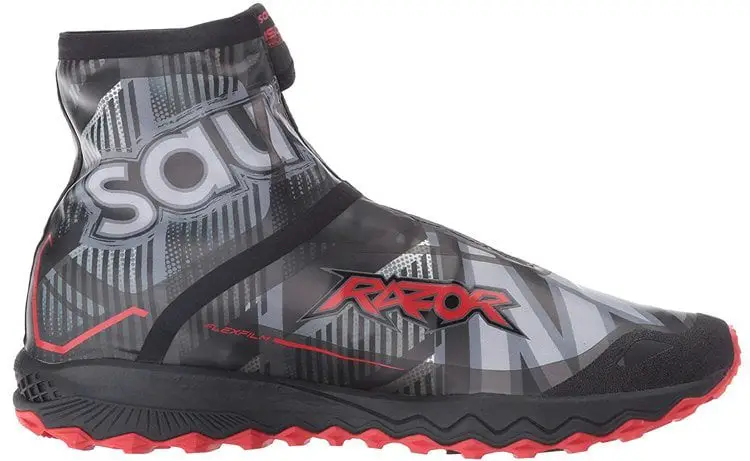
Specification
- Brand: Salomon
- Arc Support: Neutral
- Heel to Toe Drop: 11mm
- Weight: 366g
- Release Date: -
If you live anywhere where winter is accompanied by snow and ice, then these are the shoes for you. You will be surprised how well they grip the ice, and how fast you will be able to go when you wear them.
Size and Fit
These are some of the most comfortable trail shoes you will ever wear. They are surprisingly light and provide you with a snug fit that ensures your feet do not slip inside the shoe. The inbuilt weatherproof gaiter helps to keep your feet dry, while still allowing the shoe to breathe.
Pros
- 9 spikes on the outsole ensure that you will have the traction you need on icy trails.
- “SensiFit” design helps to secure your foot inside the shoe.
- ClimaShield membrane helps to keep water out while still allowing your foot to breathe.
Cons
- Can only be used on snowy or icy trails.
- The heel area may be a bit narrow for some runners.
- It is slightly heavier than most other trail running shoes, which can become a problem over long distances.

#14 Inov-8 Terraclaw 250
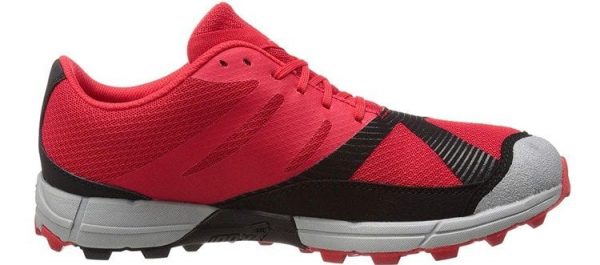
Specification
- Brand: Inov-8
- Arc Support: Neutral
- Heel to Toe Drop: 8mm
- Weight: M 250g | W 195g
- Release Date: -
If you are looking for a trail running shoe that you can use from the door to the trail, you need to consider these shoes. However, if you run technical trails, the lack of support underneath and around your foot may be a cause for concern.
Size and Fit
These shoes have an excellent fit, especially around the heel. The close-fitting heel ensures that the shoe stays in the same position always. The shoe may have a firm sole, but the midsole provides more cushioning than many people expect.
Pros
- Lightweight and durable.
- Despite having shorter traction lugs than usual, the shoes still offer excellent traction.
- The wide toe box helps to increase stability.
Cons
- It is low for protection and support, making it unsuitable for technical trails.
- Slightly more expensive than other trail shoes.

#15 La Sportiva Helios 2.0
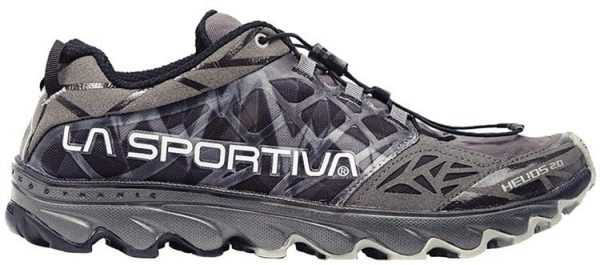
Specification
- Brand: La Sportiva
- Arc Support: Neutral
- Heel to Toe Drop: 4mm
- Weight: M 237g | W 183g
- Release Date: -
This is one of the most durable shoes you will ever buy. The fact that it is so light also means that you will be able to run for longer. However, these shoes are most suited to those that like minimal trail shoes.
Size and Fit
The fit on these shoes can be so snug that it has been suggested that you purchase a shoe a ½ a size or a full size up. The snug fit means that your feet do not keep sliding around when you are running. The mesh upper ensures that your feet are well ventilated, and the shoe is moderately well cushioned.
Pros
- Breathable upper for superior foot ventilation.
- The sole is surprisingly flexible considering its thickness.
- Traction is so good that these shoes can be used just about anywhere.
Cons
- You may have to order ½ a size or a size up to fit into the shoe properly.
- The shoe does not offer you much protection from debris.
Trail Running Shoe Buyer’s Guide
If you are new to trail running or have not been doing it for very long, you probably just picked the first nice shoes you saw. However, there are a few things that you have to consider before you buy a pair of trail shoes.
Fit is Everything
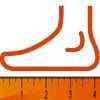
That statement is not made lightly. The fit is the most important thing to consider. Regardless of how many excellent reviews a shoe gets, you need to remember that if it does not fit your foot, then it is the wrong shoe for you.
A good fit does not just involve shoe size, length, or width of the shoe, as feet are quite complicated. A good fit will also involve things like arch shape and length, as well as volume.
The best way to know whether you are buying the right shoe is to go to a footwear specialist. These professionals will be able to analyze your feet and give you advice on what the best brands and shoes for your feet are. It is always recommended that you go to see a footwear specialist towards the end of the day when your feet have swollen a little. This is so that you can ensure that you get shoes that are big enough to fit you properly.
Foot Protection

Foot protection is important, especially if you are looking for trail running shoes. It is important that you pick a shoe that has both internal and external protection features. This will help to minimize the damage that you do to your feet, especially when running on trails with sharp rocks and roots.
Stability
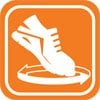
The stability of a trail shoe is very important, especially if you are planning on tackling technical trails. The more stable a shoe is, the less likely it will be for you to twist or break your ankles. Also, the more stable a shoe is, the less stress you will put on your feet, which further reduces the risk of injury.
Outsoles and Traction
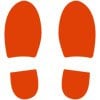
The type of outsole that your shoe has and the lug patterns that are on the outsole will affect the traction that your shoe offers you. Traction is significant, especially if you run on technical trails that have water crossings, mud, sand, and rocks. Before you purchase a trail running shoe, it is important that you consider the type of trails that you will be exploring so that you can pick a shoe with the best traction for your needs.
Midsole Cushioning

When it comes to trail shoes, it is important to consider midsole cushioning, especially if you are planning on running on trails with steep ascents and descents. The cushioning that is provided by the midsole will help to relieve some of the pressure on your feet, which will help reduce the risk of injury. Also, some shoes will have stiffer midsoles, which will help to increase the protection that the shoe delivers to you.
Waterproof is Bad, Consider Breathability
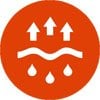
You may think that having a waterproof trail shoe would be a good idea. After all, many trails will involve a water crossing at some point. However, getting a waterproof trail shoe is usually a bad idea, as a waterproof upper often does not allow the shoe to breathe. You need to keep your feet well ventilated when you are running to avoid things like athlete’s foot and foot fungus.
Weight

Weight is another important consideration you need to make. In most cases, the lighter the shoe, the longer you will be able to run. However, some shoes are heavy because of all the protective elements that are built into the shoes. Finding a balance between protection and weight should be a priority when choosing trail running shoes.
Heel-To-Toe Drop
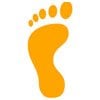
The heel-to-toe drop is basically the difference in the height between the heel and the forefoot. To decide what heel-to-toe drop is right for you, you need to consider a couple of factors:
What is the heel-to-toe drop on the running shoes you use right now? You need to come as close to that value when you are choosing your trail shoes so that you do not mess up your body’s biomechanics
The lower the heel drop, the more stable your landing platform will be, and the better your balance. However, it will also increase your muscle engagement, which means that you will be putting your feet under more strain.
It is important to note that not everyone can make the transition to a low-drop shoe, especially if they have been wearing high drop shoes for a long time.
Types of Trail Running Shoes
There are three main types of trail running shoes:
Light Trail
Light trail shoes are designed to be used on flat, or relatively flat surfaces. These include gravel paths, fire roads, and rolling hills. They are the closest in design and features to running shoes, with a few exceptions:
- Most will have better protection from rocks and roots
- They are lighter with allows you to maintain a faster pace
- They have shallow lugs for added traction on soil
Rugged Trail
As the name suggests, rugged trail shoes are designed for more demanding trails. Because of this, they have even more differences compared to road shoes including:
- Toe guards and rock plates to protect you from rocks and roots
- Durable uppers to protect you from brush and thorns
- Better midsole cushioning to help protect your feet when navigating steep terrain
- Better lug patterns to help provide you with better traction
Off Trail
Off Trail shoes are the most rugged trail shoes you can get. They have even more additional enhancements to the ones made to rugged trail shoes such as:
- Even more durable materials such as polyurethane foam midsoles
- Better torsional rigidity to ensure that the shoe continues to provide you with excellent grip even under extreme twisting force. This is especially important when you are not on flat ground
- Many off trail shoes are also highly water resistant
How is Trail Running Shoes different from Road Running Shoes?
There are quite a few differences between trail running shoes and road running shoes, some of which are listed below:
Trail Shoes offer Better Grip
Because trail shoes have lugged soles, they offer much better grip on rugged terrains like gravel, rocks, mud, sand, and roots
They offer Better Protection
Trail shoe designers know that you are more likely to damage your feet when you are trail running. Therefore, design various protections into the shoes to ensure that minimum damage is done to you.
More Rigid Construction
Trail shoes are designed specifically to ensure that your feet do not rotate too much. Also, trail running differs from road running because most times, the strides you take will be shorter as you seek the best place to land.
CONCLUSION
Trail running is one of the best ways to keep fit while exploring the environment around you. Regardless of your experience levels, the shoes outlined in this review are some of the best you will find this year.
Sign Up for our Newsletter
Get running shoe reviews straight to your inbox
Your privacy is important to us!

